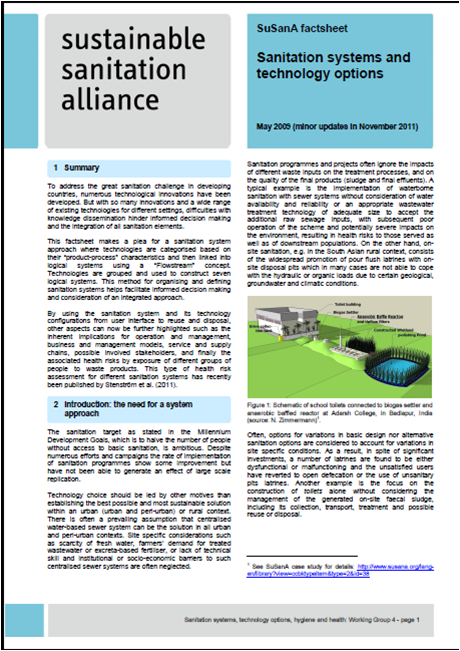Sanitation systems and technology options - Factsheet of Working Group 4
Zurbrügg, C., Panesar, A., Rüd, S. (2012)

Published in: 2012
Publisher:
Sustainable Sanitation Alliance (SuSanA)
Author:
Zurbrügg, C., Panesar, A., Rüd, S.
Uploaded by:
SuSanA secretariat
Partner profile:
common upload
10618 Views
519 Downloads
Content - Summary
To address the great sanitation challenge in developing countries, numerous technological innovations have been developed. But with so many innovations and a wide range of existing technologies for different settings, difficulties with knowledge dissemination hinder informed decision making and the integration of all sanitation elements.
This factsheet makes a plea for a sanitation system approach where technologies are categorised based on their “product-process” characteristics and then linked into logical systems using a “Flowstream” concept.
Technologies are grouped and used to construct seven logical systems. This method for organising and defining sanitation systems helps facilitate informed decision making and consideration of an integrated approach.
By using the sanitation system and its technology configurations from user interface to reuse and disposal, other aspects can now be further highlighted such as the inherent implications for operation and management (O&M), business and management models, service and supply
chains, possible involved stakeholders, and finally the associated health risks by exposure of different groups of people to waste products. Such a health risk assessment for different sanitation systems has recently been published by Stenström et al. (2011).
Last updated: 30 April, 2012
Bibliographic information
Zurbrügg, C., Panesar, A., Rüd, S. (2012). Sanitation systems and technology options - Factsheet of Working Group 4. Sustainable Sanitation Alliance (SuSanA)
Filter tags
English Factsheets and policy briefs Publications by SuSanA Publications by SuSanA Sanitation systems and technology options (WG4)















